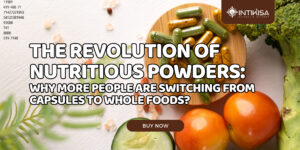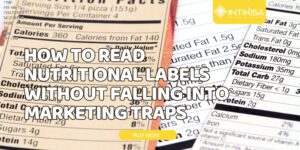These days, we’re surrounded by products claiming to be “natural,” “light,” or “healthy,” but many times those words are just window dressing. When it comes to smoothies, the difference between a natural one and a processed one can be as big as eating a fresh fruit… or drinking a beverage that only tastes like fruit.
In this article, we clearly explain why not all smoothies are created equal, what ingredients to look for (and which to avoid), and why at Intikisa we’re committed to truly natural smoothies—without tricks, fillers, or unnecessary chemicals.
🧪 Processed Smoothie: What Are You Really Drinking?
Processed smoothies aren’t made with your health in mind. Their main goal is profitability: long shelf life, addictive taste, and large-scale production with cheap ingredients. This means sacrificing real nutrients in favor of industrial ingredients that imitate nature.
Common ingredients in processed smoothies:
-
Concentrated or reconstituted juice: Unlike whole fruit, these juices are boiled at high temperatures, destroying most nutrients. They’re then rehydrated with water, losing all fiber and becoming essentially liquid sugar.
-
High-fructose corn syrup (HFCS): One of the worst types of sugar. Linked to obesity, insulin resistance, non-alcoholic fatty liver disease, and cardiovascular issues. It’s cheap, which is why it’s used.
-
Artificial flavorings: They simulate the taste of fruits (like “mango flavor”) without containing a single drop of real fruit. Many are petroleum-derived and can affect the nervous system with frequent consumption.
-
Thickeners like guar gum or carrageenan: These add a creamy texture, but some studies link carrageenan to intestinal inflammation, especially in sensitive people or those with digestive conditions.
-
Artificial colorants: Red 40, Yellow 5, etc. These provide no nutritional value and are linked in some studies to hyperactivity in children and allergic reactions.
-
Chemical preservatives: Substances like sodium benzoate or potassium sorbate keep smoothies shelf-stable for months, but may irritate the digestive system or interfere with cellular function in large amounts.
In short: What looks like a fruit drink is actually a chemically engineered product designed to appear healthy and taste good—but it loads your body with empty calories and unnecessary compounds.
🍓 Natural Smoothie: What It Should Contain
A natural smoothie is the exact opposite: it’s made to nourish, not deceive. It uses real ingredients that, being minimally processed, retain their natural properties. That means they not only taste good, but truly support your health.
At Intikisa, we use:
-
Whole fruits, dried or freeze-dried: These preservation methods keep fruits chemical-free while retaining their vitamins, minerals, antioxidants, and fiber. It’s not the same as juice—you’re consuming the whole fruit.
-
Andean superfoods: Ingredients like maca (natural energizer), lucuma (rich in iron and beta-carotene), camu camu (an extremely high source of vitamin C), or native cacao (a natural antioxidant and mood booster) are the foundation of our smoothies. And unlike many brands, we don’t use them in trace amounts—they’re our main ingredients.
-
Functional seeds: Chia, flaxseed, sacha inchi… these are loaded with omega-3, plant-based protein, and fiber. They support heart health, improve digestion, and help keep you feeling full longer.
-
Natural plant extracts: Like yacon (to regulate glucose), moringa (a natural multivitamin), or aguaje (rich in phytoestrogens and vitamin A).
-
Zero added sugar, zero chemicals, zero artificial flavors: Our smoothies are naturally sweet, thanks to real ingredients. No industrial cover-ups needed.
The result? A smoothie with natural taste and texture, one that supports digestive health, boosts your immune system, and gives you steady, lasting energy.
📋 What Should You Check Before Buying a Smoothie?
Buying healthy isn’t just about marketing—it’s about reading labels. Here are the four key things to look for:
✅ Short, understandable ingredient list
A good rule: if you can’t pronounce it, you probably shouldn’t eat it.
Ingredients should be things you’d find in your kitchen, not a chemistry lab.
Ideal example (natural):
Freeze-dried banana, lucuma, ground chia, maca, camu camu extract.
Bad example (processed):
Water, sugar, apple juice concentrate, maltodextrin, xanthan gum, natural flavor, Red 40, citric acid, sodium benzoate.
✅ No artificial flavors or colors
Many products say “strawberry flavor,” but contain no real strawberry—just chemicals mimicking its taste.
Some dyes, like Red 40, are even banned in parts of Europe due to potential health risks.
Look for smoothies that say “natural strawberry flavor from real fruit”—or better yet, that use actual dried strawberries.
✅ Whole fruit vs. concentrated juice
Concentrated juices go through heating, filtering, and storage processes that strip away nutrients. They lose their fiber and key health benefits.
Whole fruit, however, retains its cellular structure, helping to:
-
Regulate digestion.
-
Slow sugar absorption (lower glycemic index).
-
Keep you full longer.
A smoothie made with whole fruit nourishes you. One made with juice concentrate just sweetens you.
✅ No added sugars or artificial sweeteners
Added sugars go by many names: corn syrup, fructose, dextrose, inverted sugar, etc. These spike your blood sugar, give a quick energy rush, and then a crash that leaves you hungrier.
And if the smoothie is “sugar-free,” it often contains artificial sweeteners like:
-
Aspartame
-
Sucralose
-
Acesulfame K
Even though they’re calorie-free, studies show they may alter gut microbiota and increase sugar cravings—not a better option.
At Intikisa, we use neither. Just the natural sweetness of fruits.
❌ What Intikisa never uses (and never will)
Our philosophy is simple: If your grandma wouldn’t recognize it as food, it doesn’t go in our smoothies.
That’s why our products are guaranteed to be free from:
-
Fillers like maltodextrin or modified starch.
-
Artificial flavors or colors.
-
Added sugars or artificial sweeteners.
-
Synthetic preservatives or unnecessary additives.
-
Lab-made ingredients.
We use only real ingredients, carefully sourced in Peru, processed without compromising their properties, and certified (FDA, Kosher) to ensure quality and transparency.
💡 Why Does This Matter?
Because what you consume daily builds—or breaks—your health.
A smoothie with sugar, colorants, and chemicals may seem harmless once in a while, but if it becomes a habit, it can:
-
Raise your blood sugar.
-
Damage your gut microbiome.
-
Cause chronic inflammation.
-
Increase long-term risk of metabolic disease.
On the other hand, a natural smoothie with superfoods can:
-
Improve digestion thanks to its fiber.
-
Strengthen your immune system with antioxidants.
-
Boost your energy in a stable, natural way.
-
Reduce cravings for sugar or junk snacks.
In short: natural isn’t a trend. It’s a necessity.
✅ Discover What’s Really Inside Our Products
At Intikisa, we don’t promise miracles. We offer something better:
honest products, made with ingredients you know and benefits you can actually feel.
Our smoothies are made for real people, with real routines, who want to care for themselves—without overcomplicating things.
And yes, they taste amazing.
But more importantly, they truly nourish your body.








